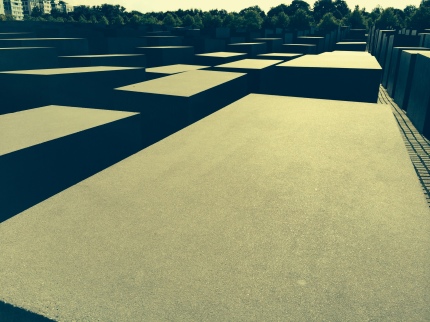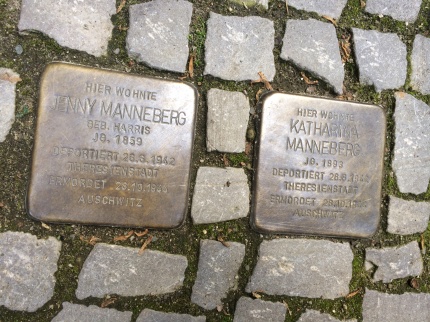In spring 2015 I was asked to speak on “synchronicity” on a shared panel with my distinguished colleagues Gabriele Brandstetter and Susan Foster. Returning to the IRC for a brief visit the year after my extended stay, I took the occasion to reflect on my experience of Berlin during visits decades apart, the shifting landscapes of the city.
In my research and writing, the concept of synchronicity suggests the interrelations between dance texts and historical contexts. Give me a historical event or period designation – the Progressive Era, the Jazz Age, the Great Depression, the rise of fascism, the Cold War, the Fall of the Berlin Wall – and I can spin a story of how dance shaped and was shaped by that historical moment. In fact, while preparing my talk, I realized that the noun “synchronicity,” according to the Oxford English Dictionary, was coined by C.G. Jung to refer to “the phenomenon of events which coincide in time and appear meaningfully related but have no discoverable causal connection.”
During my residency at the IRC in spring 2014, I spent my off-hours exploring the synchronicities of contemporary dance and culture in Berlin. Although I didn’t truly participate in the electronic dance and music scene that engages so many visitors to Berlin, I did wonder about its relationship to the contemporary dance scene, which I did explore in depth at Dock 11, HAU, Sophiensaele, Tanzfabrik, Uferstudios. I was reminded of the 1930s in New York City, where so many participants in the emergent modern dance scene downtown in Greenwich Village also spent time at the Savoy Ballroom uptown in Harlem. What was the relationship between the angular and percussive style of early Martha Graham and the rhythms of swing, arguably created through the interactions of dancers and musicians at the Savoy? I’m not sure, although I sense a meaningful synchronicity. What’s needed is an inquiry into the shared movement environment not only of 1930s New York City but also of 21st century Berlin. (“Movement environment” is a concept that Cynthia Novack coined in Sharing the Dance, her study of contact improvisation in relation to other dance and movement forms in US culture during the 1970s and 1980s.)
What might an inquiry into the movement environment of present-day Berlin reveal? In spring 2014 I asked a scholar of contemporary dance at the Free University if she saw a relation with the club scene, and she answered no, contemporary choreographers were not influenced by the electronic dance and music scene. In my sole experience of the club scene, a low-key Sunday afternoon at Else’s outdoor space adjoining Treptower Park, I was struck by the promise of liberation and the reality of surveillance. First, as Berliners well know, one has to pass muster at the gate to get in. As an aging woman with gray hair, I would not have attempted this on my own, but when my older son came for a short visit, we decided to try our luck by making up imaginary friends whom we were supposed to meet inside. I’m sure the bouncer only allowed us in because there were just not many folks there. No one was dancing, to my disappointment, but I found the spatial design fascinating – its upper and lower levels, tunnel and nooks and crannies, and view of the river, the Elsenbrücke. We took photos, as tourists are wont to do, and the bouncer suddenly appeared from nowhere and nearly confiscated our cell phones before kicking us out. How to explain this paradox of liberation and surveillance?
When I asked a friend of a friend, she said that the club scene of the 1990s had crystallized the experience of the years right after the Fall of the Wall, when the sudden liberation of East Berlin collided with the exposure of a surveillance culture and the opportunities and oppressions of a Western-style capitalist market economy. But now, she said, the club scene was limited to a local subculture and the tourist economy and no longer carried the multidimensional resonance it had at the end of the last century.
If the synchronicity between contemporary dance and the Berlin club scene remains an open question, I was struck by the synchronicity between contemporary dance and other tourist destinations in the city, namely, the multitude of sites commemorating German-Jewish life and the Holocaust. The theme of history and memory, omnipresent in contemporary dance, also informs the commemoration culture of the built environment.
In contrast to my sole excursion to Else, I was an assiduous tourist of the Jewish past, spending hours not only at the mainstays on any tourist’s itinerary – the Jewish Museum and the Holocaust Memorial – but also visiting other sites: the synagogue and community center on Fasanenstrasse, its postwar reconstruction set at a defensive distance back from the street and its gated courtyard heavily patrolled; the Moses Mendelsohn School, formerly the Jewish Free School, and the nearby grave marker for Mendelsohn on Grosse Hamburgerstrasse; the Jewish Girls School and Jewish Hospital on Auguststrasse, just down the street from Clärchens Ballhaus; the Abandoned Room Monument at Koppenplatz, originally designed by the DDR to commemorate the 50th anniversary of Kristallnacht in 1988, but not realized until after the Fall of the Wall; and Gleis 17 at the Grünewaldstrasse S-Bahn station, the site from which 35,000 Berlin Jews were deported, each deportation marked along a reconstructed track to nowhere by the date, number of deportees, and destination – Lodz, Minsk, Kowno, Riga, Lublin, Warsaw, Theresienstadt, Auschwitz.
I had first spent extended time in Berlin exactly thirty years before my residency at the IRC. With a DAAD graduate-student grant in 1984, I had come to Berlin to research Mary Wigman’s dances at the Academy of Arts in West Berlin, at 10 Hanseatenweg in the Tiergarten near the Zoo. (Neither the West nor the East Berlin Academy of Arts then stood on the early-twentieth site on Pariser Platz, where a newly erected Academy opened in 2005.) By day the archive on Hanseatenweg yielded documentation of Wigman’s multidimensional career – her solo cycles and group works from the 1920s (Scenes from a Dance Drama, Visions, Shifting Landscape) and her ambivalent collaboration with the National Socialists. By night the complexities of life in Berlin animated my conversations at Kneipen, pubs in neighborhoods that are barely mentioned in today’s tourist guides, so decisively has the center of the city moved East.
In 1984 the city compelled me precisely because one lived on the fault-lines of twentieth-century history – the geopolitical division of the Cold War was omnipresent in the divided city, of course. But so too was the Nazi past, not in terms of the built environment, but in conversation, as I spent many late nights sharing family stories with new friends – a Jewish émigré nearly my father’s age, a painter who now divided his time between New York and Berlin; a theatre journalist, also older than me, who remembers his father willingly acknowledging his Nazi Party membership at the end of the war and leaving for a Soviet prison camp, never to return; other friends around my age whose parents mostly kept silent about the past, leaving them to wonder all the more urgently about what had happened.
I returned to Berlin briefly in 2004, and remember reflecting on the large-scale rebuilding of the city while sitting in a café near the Moorish-style Neue Synagogue on Oranienburg Strasse, its restoration initiated just before the Fall of the Wall and completed afterward. Twenty years before in Berlin, one had experienced the complexities of 20th century European history first-hand, but now the city seemed engaged in a wholesale attempt to narrate that history. Crossing Checkpoint Charlie in 1984 was no laughing matter, but 20 years later a plethora of tourist shops now marked that spot and my then-teenage son brought a sign to decorate his bedroom at home: Eintritt verboten. Do Not Enter.
When I arrived in spring 2014 the rescripting of Berlin’s history seemed complete. Now the Nazi past and the Holocaust had become tourist destinations. Against this backdrop, I began my intensive viewing of contemporary dance in Berlin, and found myself most drawn to the many works that reference dance history, not surprisingly, given my profession. On my way to performances, I would pause and read each Stolpernstein (“stumbling stone”) embedded in the pavement. Once at the theatre I would take pleasure in recognizing the myriad references embedded in the works: Xavier Le Roy’s Exhibition as Choreography/ Choreography as Exhibition, his installation with FU master’s students in Tanzwissenschaft that included brief excerpts from works by Vaslav Nijinsky, Mary Wigman, Yvonne Rainer, Trisha Brown, Pina Bausch, and Anna Teresa De Keersmaeker; Martin Nachbar’s Urheben Aufheben, his wry account of attempting to reconstruct Dore Hoyer’s 1962 solo cycle Affectos Humanos; Boris Charmatz’ installation, Expo Zero, a manifestation of his Musée de la danse, during which the choreographer strung together excerpts from Petipa’s Swan Lake, Nijinsky’s L’Apres midi d’un Faune and Le Sacre du Printemps, Wigman’s Hexentanz, Kurt Jooss’ Der grüne Tisch/The Green Table, Trisha Brown’s Water Motor, and Tino Sehgal’s Twenty Minutes for the Twentieth Century.
Although there is a smaller audience for these works than, for example, Sasha Waltz, scholars have devoted far more attention to Nachbar, Le Roy, and Charmatz than to Waltz. Federal funding has followed scholarly interest: in fact, there is a broad-based funding initiative, Tanzfonds Erbe, that asks choreographers to explore history and memory in works by twentieth-century choreographers and acknowledge “the gaps in any dance reconstruction” – to quote the project’s website. Among the subsidized works I saw, the best was Christina Cuipke and Anna Till’s Undo, Redo and Repeat with sections devoted to Wigman, Kurt Jooss via Reinhild Hoffmann, Dore Hoyer via Martin Nachbar, Pina Bausch, and William Forsythe.
At home in Chicago, I had read eloquent accounts of Nachbar and Le Roy, among other European conceptualists, but within the built environment of Berlin their works took on meanings that I could not fathom from afar. Let me be clear: from a distance, I couldn’t really understand why this mode of self-reflexive reference to dance history had become so influential. But once in Berlin, these works resonated powerfully against the commemoration culture of the Jewish Museum, Holocaust Memorial, and Gleis 17. I cannot fully describe this synchronicity, but I clearly sensed how these choreographers, along with museum architects and curators, were compelling their publics to reflect on how history is told, how historical narratives interweave memory and archive, and how fragments of the past surface in the present. Synchronicity underlies the history of the present as well as the past.



